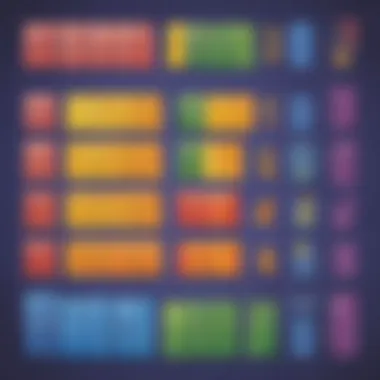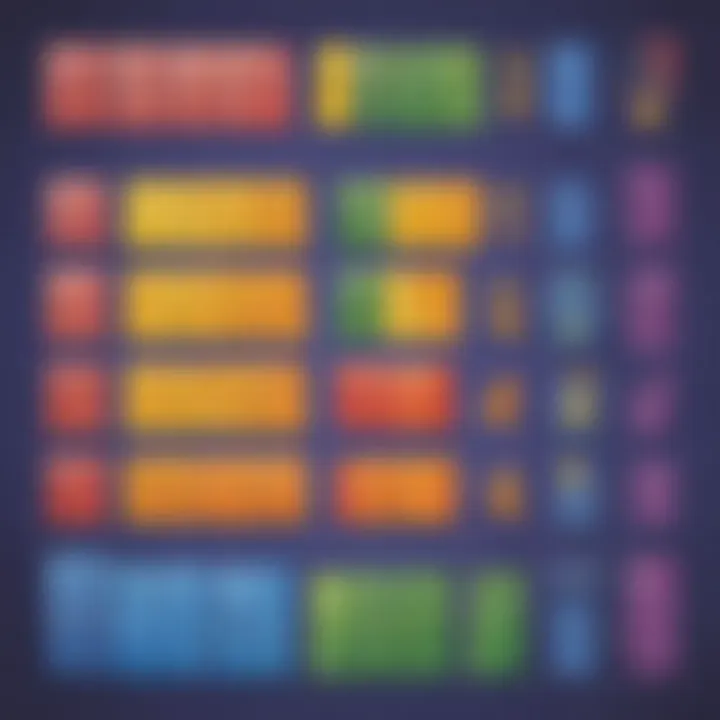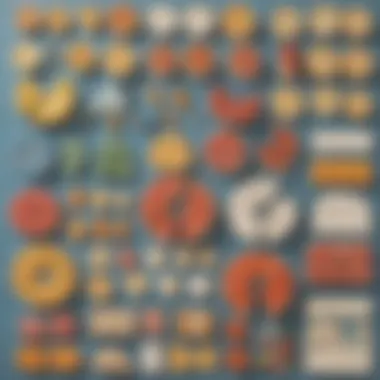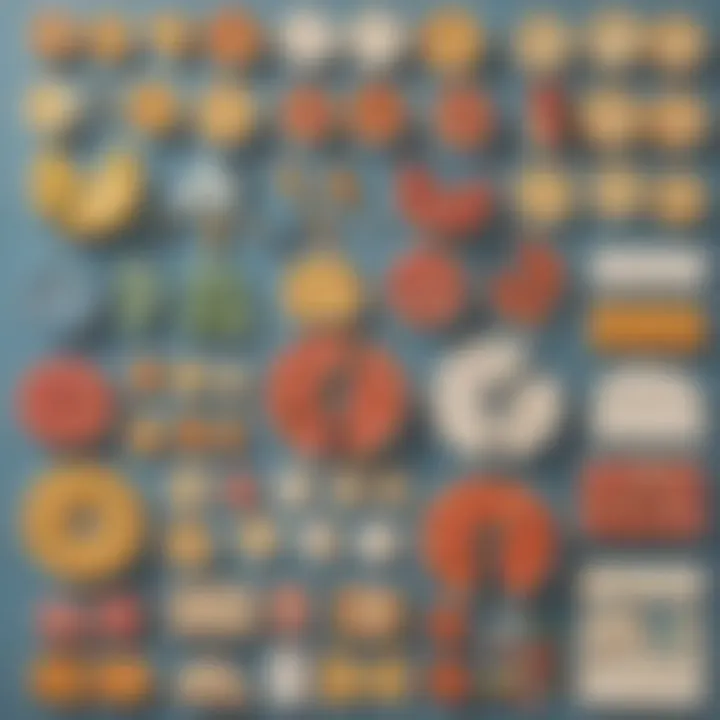Mastering the Art of Equivalent Fractions


Intro
This section will discuss the importance of equivalent fractions, providing a clear framework that will help elementary school children grasp the significance of this topic. By exploring definitions, visual aids, and practical examples, this article aims to make learning about fractions both enlightening and accessible.
Creative Activities
Engaging activities can enhance the understanding of equivalent fractions. Here are some fun ways to explore this mathematical concept creatively.
Craft Ideas
- Fraction Circles: Use colored paper to create circles divided into different segments. Children can cut these circles into pieces to visually see how fractions are equivalent.
- Fraction Cards: Create cards with various fractions written on them. Children can match equivalent fractions by finding cards that represent the same value.
Step-by-Step Guides
- Make the Fraction Circle:
- Match the Fraction Cards:
- Get a piece of paper and draw a large circle.
- Divide this circle into equal parts based on different fractions, like 1/2, 1/3, and 1/4.
- Color each section differently.
- Write down fractions like 1/2, 2/4, and 3/6 on separate cards.
- Shuffle the cards and ask children to find pairs of equivalent fractions.
Educational Value
Doing these activities helps children visualize and internalize the idea of equivalent fractions. By manipulating physical objects, they can discover relationships between different fractions, reinforcing their understanding through hands-on experience.
Fun Quizzes
Quizzes can be an engaging way to reinforce the knowledge of equivalent fractions through fun challenges.
Quiz Topics
- Recognizing Equivalent Fractions
- Simplifying Fractions
- Comparing Different Fractions
Question Types
The quizzes may include:
- Multiple choice questions to select the correct fraction.
- Fill-in-the-blank questions where children must write their answers.
- True or false statements regarding fraction values.
Knowledge Reinforcement
Quizzes help reinforce learning by allowing students to apply their knowledge in a structured way. They can see where they excel and where they might need further practice, enhancing their understanding of the subject.
Fact-Based Articles
A good variety of articles can complement the learning experience of equivalent fractions.
Topics
- The importance of fractions in real life.
- History of how fractions were used in ancient civilizations.
- Different methods to simplify fractions.
Engaging Content
These articles present information in a straightforward manner. They can include visuals and examples to aid comprehension, ensuring that young learners are engaged and informed.
Prologue to Fractions
The topic of fractions serves as a fundamental building block in mathematics. Understanding fractions allows children to grasp more complex concepts, such as ratios and proportions, which appear frequently in everyday contexts. This section gives an overview of what fractions are, paving the way for a deeper exploration of equivalent fractions. Knowing about fractions is not just important for academic reasons; it enhances problem-solving skills and logical thinking in various life situations.
What is a Fraction?
A fraction represents a part of a whole. It is composed of a numerator and a denominator. The numerator indicates how many parts we have, while the denominator shows how many equal parts the whole is divided into. For example, in the fraction 3/4, 3 is the numerator, representing three parts, and 4 is the denominator, indicating that the whole is divided into four equal parts.
Fractions can be used in countless real-life scenarios, such as cooking or dividing items, making them relatable and practical for elementary school children. They often encounter fractions when sharing pizzas, cakes, or candies with friends, providing a strong foundational understanding of this topic.
Types of Fractions


Understanding the various types of fractions helps in recognizing their unique characteristics and how they fit into real-world applications. Here we will discuss three main types: Proper Fractions, Improper Fractions, and Mixed Numbers.
Proper Fractions
Proper fractions are fractions where the numerator is less than the denominator. For example, in the fraction 2/5, 2 is less than 5, making it a proper fraction. This type of fraction is beneficial as it clearly represents a quantity less than one, which is often simpler for children to understand.
Proper fractions can be visually represented, allowing learners to see the part-whole relationship clearly. They serve as a good introduction to fractions because they reinforce the concept that parts must be less than the whole. However, they may limit understanding when it comes to quantities that exceed one.
Improper Fractions
Improper fractions are defined as fractions in which the numerator is greater than or equal to the denominator. An example would be 7/4. Because the numerator is larger than the denominator, this fraction represents a quantity greater than one.
While improper fractions can be confusing at first, they provide essential insight into fractional numbers beyond one whole. They encourage students to think critically and develop problem-solving skills, especially when they learn to convert them into mixed numbers. One disadvantage is that they can be less intuitive, especially for young learners.
Mixed Numbers
Mixed numbers consist of a whole number combined with a proper fraction. For instance, the mixed number 2 1/3 represents two whole parts and one-third of another part. Mixed numbers become useful as children learn to compare quantities over one whole, expanding their understanding of numbers.
They can be more relatable for learners, as they connect with real-world scenarios, like measuring ingredients in recipes. However, converting mixed numbers into improper fractions and vice versa can be a hurdle, requiring practice and application for mastery.
In summary, understanding the different types of fractions lays the groundwork necessary for exploring equivalent fractions effectively. Each type contributes to diverse areas of mathematics and supports overall numerical literacy.
Defining Equivalent Fractions
What Does 'Equivalent' Mean?
The term "equivalent" means equal in value or amount. In the context of fractions, it indicates that two fractions express the same portion of a whole. For instance, the fractions 1/2 and 2/4 are considered equivalent because they represent the same quantity when visualized or calculated. This concept is critical in mathematics because it allows for flexibility in problem-solving. For example, equivalent fractions can simplify operations and make calculations easier and more accurate.
Characteristics of Equivalent Fractions
Identifying equivalent fractions involves recognizing specific characteristics:
- Same Value: Despite having different numerators and denominators, equivalent fractions yield the same result when expressed as decimals or when calculated.
- Scale Factor: They can be found by multiplying or dividing both the numerator and the denominator by the same non-zero number. For example, multiplying 1/3 by 2/2 gives 2/6, which is equivalent to 1/3.
- Visual Representation: When drawn on a number line or in pie charts, equivalent fractions occupy the same position or area, confirming their equality.
By grasping these characteristics, students can confidently navigate through various mathematical challenges involving fractions.
Visualizing Equivalent Fractions
Visualizing equivalent fractions is an essential component in grasping this mathematical concept. This section explains how visual aids can clarify the idea of fractions being equivalent. By using visual tools, students can better understand how different fractions can represent the same portion of a whole. Engaging with these representations makes learning easier and more relatable for young minds, allowing them to see the connections between numbers and real-life scenarios.
Using Fraction Bars
Fraction bars are helpful in illustrating equivalence. They are simple bars divided into equal parts. Each part represents a fraction of the whole. For example, if a fraction bar is divided into four equal sections, each section represents 1/4.
To show equivalent fractions, compare different fraction bars. For instance, if you take two bars: one divided into two equal parts (1/2) and another divided into four parts (2/4), you can line them up to see they cover the same length. This visual is powerful because it allows students to spatially understand that different fractions can represent the same value.
Using fraction bars in class activities not only reinforces the concept but also fosters teamwork. Students can work in pairs to manipulate physical fraction bars or use online tools to visualize fractions. This kinesthetic approach helps solidify their understanding as they can see the fractions align.
Pie Charts for Understanding
Pie charts are another excellent way to visualize equivalent fractions. They display how a whole can be separated into slices. Each slice represents a part of the whole, clearly showing how many parts make up one whole.
Consider a pie chart divided into four equal slices. Each slice is 1/4 of the pie. Now, if you take two of those slices, that would equal 2/4. By coloring in or shading the slices, students can visually compare these fractions. Seeing the 1/2 pie is essentially the same as having 2 out of 4 parts reinforces the concept of equivalence.
Pie charts are particularly engaging for young learners because they relate to food, a topic they find relatable. This context makes it easier for them to absorb the idea. Including activities where students can create their pie charts helps solidify their understanding. They can use real-life scenarios, such as sharing a pizza, to illustrate fractions effectively.
How to Generate Equivalent Fractions
Generating equivalent fractions is a crucial aspect of understanding fractions. This concept serves as the foundation for many mathematical operations involving fractions. By knowing how to create equivalent fractions, learners can simplify complex fraction problems and relate different fractions to each other. In addition, grasping this technique allows for improved problem-solving skills in various real-life situations, such as cooking or sharing resources. Understanding how to manipulate fractions is essential for future math learning and everyday uses.
Multiplying by the Same Number
One effective method to generate equivalent fractions is by multiplying both the numerator and the denominator by the same non-zero number. This approach works because multiplying the top and bottom by the same number does not change the overall value of the fraction. For example, converting the fraction 1/2 into equivalent forms can be illustrated as follows:
- 1/2 × 2/2 = 2/4
- 1/2 × 3/3 = 3/6
- 1/2 × 4/4 = 4/8
In each case, we multiply the numerator (the top number) and denominator (the bottom number) by the same multiplier. The value remains unchanged, and each resulting fraction is equivalent to the original 1/2. This method is simple and effective. It enables students to create an endless number of equivalent fractions with relative ease. Encouraging students to practice this process can enhance their fraction skills significantly.


Dividing by the Same Number
Conversely, dividing the numerator and denominator by the same non-zero number also produces equivalent fractions. This method is less commonly mentioned but equally valuable. By reducing the fractions to simpler forms, it can be easier to understand relationships between different fractions. Suppose we have the fraction 4/8; we can divide both numbers by 4:
- 4/8 ÷ 4/4 = 1/2
Similarly, we can express two fractions:
- 6/9 ÷ 3/3 = 2/3
- 10/15 ÷ 5/5 = 2/3
In both examples above, dividing both the numerator and the denominator gives us a simplified fraction. Thus, understanding how to divide fractions reinforces the concept of equivalence and encourages students to think critically about their mathematical choices. Both methods—multiplying and dividing—give learners tools to explore fractions creatively yet practically.
"Finding equivalent fractions takes practice, but mastering it offers a solid foundation for future math concepts."
Real-World Applications
Cooking and Baking
In the kitchen, equivalent fractions often come into play. Recipes typically require measurements that can vary in size, and being able to convert these measurements is crucial. For instance, a recipe might need one cup of sugar, but you may only have a half-cup measuring cup. Knowing that two half-cups equal one cup illustrates the concept of equivalent fractions clearly.
Another scenario is when adjusting a recipe. If a dish serves four people and you want to make it for eight, you need to double all your ingredients. This means converting one fourth of a cup to one half of a cup. By understanding that one half is equivalent to two fourths, cooking becomes easier and more enjoyable. This practical application helps reinforce mathematical learning.
Shopping Scenarios
Shopping also provides a perfect context for equivalent fractions. When comparing prices, one might encounter situations like a sale. If a 12-ounce bottle of juice costs six dollars and a 24-ounce bottle costs twelve dollars, being able to identify that both give you the same price per ounce is key. This situation demonstrates how equivalent fractions can lead to better purchasing decisions.
When looking at discounts, knowing how to apply equivalent fractions can be useful. For example, if a sweater originally costs fifty dollars and is on sale for thirty-five dollars, the discount can be expressed as a fraction of the original price, making it easier to comprehend. Thus, fraction knowledge aids in making informed choices as a consumer.
The ability to apply equivalent fractions effectively can save both time and money in everyday tasks, making them practical skills for learners to develop.
Challenges in Learning Equivalent Fractions
Common Misconceptions
One prevalent misconception about equivalent fractions is the belief that they always need to look alike. Many students think that fractions must be visually similar to be considered equivalent. For example, they may focus solely on the graphical representation rather than the numerical values. This misunderstanding can lead to confusion when students encounter fractions that, while different in appearance, actually represent the same value, like 1/2 and 2/4.
Another misconception is regarding the role of the numerator and denominator. Some learners might assume that only changing the numerator affects the value of the fraction. In reality, changing both the numerator and denominator equally preserves the fraction's value. This lack of understanding can create a solid barrier when trying to generate equivalent fractions.
Strategies for Overcoming Difficulties
To tackle these misconceptions, educators can utilize several strategies aimed at reinforcing the concept of equivalent fractions.
- Visual Aids: Make use of visual representations like fraction bars and pie charts. These tools can clarify how different fractions relate to one another, helping students see visually how fractions like 1/2 and 2/4 are equivalent.
- Hands-On Activities: Engaging students in hands-on fraction activities can solidify their understanding. For instance, using manipulatives such as blocks or dots allows students to physically rearrange pieces to explore equivalent fractions.
- Reinforce with Real-Life Examples: Integrating real-life situations where equivalent fractions are applicable can enhance relevance. For instance, discussing recipes, measurements, or even concepts in shopping can prepare learners to see the practical application of what they learn in class.
- Practice Problems: Provide a variety of practice problems that specifically focus on identifying and generating equivalent fractions. This allows students to apply their knowledge in different contexts and strengthens their understanding.
Activities to Reinforce Learning
Engaging students with activities that reinforce learning is crucial in understanding complex concepts like equivalent fractions. These activities not only solidify knowledge but also make the learning process enjoyable. When children participate in hands-on activities, they often retain information better. This approach allows them to see fractions in a practical and relatable context.
By facilitating interactive learning, parents and educators can guide children through the challenges of understanding fractions. This section will focus on two significant types of activities: interactive games and worksheets. Both components enhance comprehension and application of equivalent fractions.
Interactive Games
Interactive games present an effective way to learn about equivalent fractions. Children naturally engage in gameplay, which can foster a positive attitude towards learning. These games often utilize technology or physical materials to create a fun environment.
Some valuable aspects of interactive games include:
- Immediate Feedback: Players can see their results instantly, which helps them understand concepts better.
- Motivation: Game elements like scoring and competition drive children to participate actively.
- Reinforcement of Concepts: Games designed around equivalent fractions encourage repeated practice in a low-pressure setting.
Examples of interactive games might include:
- Fraction Bingo: Where players match equivalent fractions on their cards.
- Online Fraction Puzzles: Websites like en.wikipedia.org offer various games focused on equivalent fractions.
Worksheets and Puzzles
Worksheets and puzzles are traditional yet effective tools for reinforcing children's understanding of equivalent fractions. These resources enable structured learning and provide opportunities for independent practice. With worksheets, children can work through problems at their own pace, which is valuable for solidifying their skills.
Benefits of using worksheets include:


- Variety of Problems: Worksheets can present a range of problems that address different learning levels.
- Visual Learning: Students can visualize fractions and their equivalence through diagrams and drawings on worksheets.
- Assessment of Understanding: Completing worksheets allows educators to gauge student comprehension clearly.
Worksheets may include activities such as:
- Matching exercises: Where students pair equivalent fractions.
- Fill-in-the-blank problems: Which encourage active problem-solving.
Incorporating both interactive games and worksheets can significantly enhance the learning experience around equivalent fractions.
"Learning through play not only promotes engagement but also deepens understanding in a way that traditional methods sometimes do not."
By utilizing a mix of activities, parents and educators can create a well-rounded approach to teaching this essential concept.
Connecting Equivalent Fractions to Other Concepts
Addition and Subtraction of Fractions
Addition and subtraction of fractions often involve finding a common denominator. Equivalent fractions play a key role in this process. For example, if you want to add 1/4 and 1/6, students must first convert these fractions to equivalent ones with a common denominator. The least common denominator, in this case, is 12. Thus,
- 1/4 is equivalent to 3/12, and
- 1/6 is equivalent to 2/12.
Some important points to remember are:
- Always find equivalent fractions for smooth addition and subtraction.
- It is crucial to ensure that fractions being added or subtracted have the same denominator.
By mastering equivalent fractions, students can simplify their approach to arithmetic involving fractions, rendering it more intuitive and less cumbersome.
Fractions and Decimals
The relationship between fractions and decimals is another crucial area where equivalent fractions come into play. Converting fractions to decimals often involves identifying equivalent fractions. For instance, consider the fraction 1/2. To find its decimal equivalent, divide the numerator by the denominator, resulting in 0.5. Understanding that 1/2 is equivalent to 2/4 can make this clearer for students: both represent the same numerical value.
Here are some simple conversions:
- 1/2 = 0.5
- 1/4 = 0.25
- 3/4 = 0.75
Knowing how to work with equivalent fractions strengthens a student's ability to convert between these two formats seamlessly. Mastery of both fractions and decimals facilitates various applications, from calculating money in everyday life to solving problems in more complex math topics.
As students explore these connections, they not only enhance their mathematical skills but also realize the relevance of fractions in real-world scenarios.
In teaching, it's important to highlight how fractional relationships are applied in everyday activities, from cooking to shopping, enhancing their value and significance beyond the classroom.
Summary
Learning about equivalent fractions builds a bridge to more advanced topics in mathematics. It equips students with the necessary skills to perform addition and subtraction of fractions, convert between fractions and decimals, and understand proportional reasoning. Furthermore, when children grasp the idea of equivalence, they start to appreciate numbers beyond basic arithmetic.
In summary, this section synthesizes the key elements surrounding equivalent fractions. It lays the groundwork for enhanced mathematical understanding, benefiting both students and those helping them learn. For elementary students, mastering this concept is a meaningful step in their academic journey, setting them up for success in future math challenges.
Key Takeaways on Equivalent Fractions
- Definition: Equivalent fractions are different fractions that represent the same number or value. For instance, 1/2 is equivalent to 2/4, as both represent the same portion of a whole.
- Identification: To identify equivalent fractions, one can multiply or divide both the numerator and denominator by the same non-zero number. This operation does not change the fraction's value. For example:
- Visual Representation: Visual aids, like fraction bars or pie charts, can greatly enhance understanding of equivalent fractions. They provide tangible illustrations of how different fractions can look while representing the same value.
- Real-Life Application: Equivalent fractions can be found in cooking, shopping, and daily comparisons, making them relevant beyond the classroom. They assist in converting measurements or understanding portion sizes.
- Challenges: Students often face misconceptions about equivalent fractions, mistaking comparisons of numerators or denominators as indicators of size without recognizing the overall value represented.
- Multiply: 3/4 = (3×2)/(4×2) = 6/8.
- Divide: 6/8 = (6÷2)/(8÷2) = 3/4.
By focusing on these takeaways, learners can develop a solid foundation that not only enhances their mathematical understanding but also promotes confidence in dealing with fractions and quick connections to other mathematical principles.
Learning through visuals and practical examples solidifies the concept of equivalent fractions, creating a pathway to deeper mathematical comprehension.
Further Reading and Resources
Books for Young Learners
Books are essential for instilling a love of learning about mathematics. They offer structured content, engaging illustrations, and examples that can help young learners grasp the concept of equivalent fractions. Recommended titles include:
- "Fraction Frenzy" by William J. Smith - This book incorporates colorful illustrations and engaging stories, making it an excellent introduction to fractions for young readers.
- "Give Me Half!" by Stuart J. Murphy - A delightful approach to fractions and sharing, directly addressing the idea of equivalent fractions in a practical context.
- "Fraction Fun" by David A. Adler - This book provides a playful exploration of fractions with clear explanations and relatable examples.
These books can be found in libraries or online, and they offer enriching perspectives on the subject. Encouraging children to read such books allows them to process information in a variety of contexts, making learning more interactive and enjoyable.
Online Educational Resources
In today’s digital age, online resources play a vital role in enhancing learning experiences. Various websites provide interactive tools, games, and further explanations on equivalent fractions. Some notable resources include:
- Khan Academy (khanacademy.org) - Offers comprehensive lessons and practice problems focusing on equivalent fractions with detailed video tutorials.
- National Council of Teachers of Mathematics (nctm.org) - This site features lesson plans and activities designed to deepen understanding of fractions in engaging ways.
- PBS Kids (pbskids.org) - The site includes fun games and activities that can help reinforce concepts of fractions and equivalency through play.
Utilizing these online platforms can create a dynamic learning environment. Students can engage at their own pace and revisit challenging concepts multiple times.







